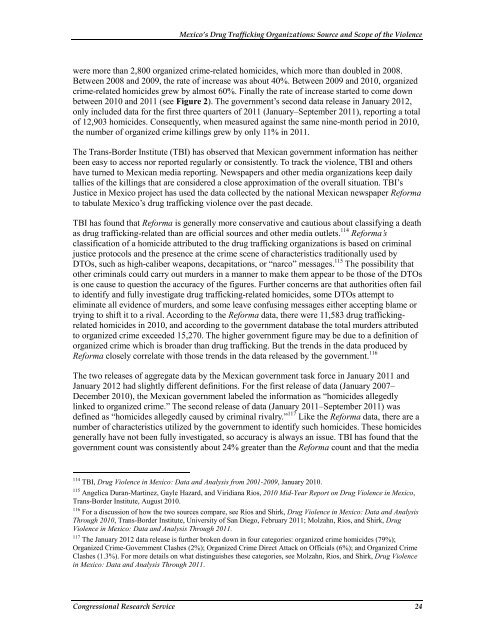Mexico's Drug Trafficking Organizations - Federation of American ...
Mexico's Drug Trafficking Organizations - Federation of American ...
Mexico's Drug Trafficking Organizations - Federation of American ...
Create successful ePaper yourself
Turn your PDF publications into a flip-book with our unique Google optimized e-Paper software.
Mexico’s <strong>Drug</strong> <strong>Trafficking</strong> <strong>Organizations</strong>: Source and Scope <strong>of</strong> the Violence<br />
were more than 2,800 organized crime-related homicides, which more than doubled in 2008.<br />
Between 2008 and 2009, the rate <strong>of</strong> increase was about 40%. Between 2009 and 2010, organized<br />
crime-related homicides grew by almost 60%. Finally the rate <strong>of</strong> increase started to come down<br />
between 2010 and 2011 (see Figure 2). The government’s second data release in January 2012,<br />
only included data for the first three quarters <strong>of</strong> 2011 (January–September 2011), reporting a total<br />
<strong>of</strong> 12,903 homicides. Consequently, when measured against the same nine-month period in 2010,<br />
the number <strong>of</strong> organized crime killings grew by only 11% in 2011.<br />
The Trans-Border Institute (TBI) has observed that Mexican government information has neither<br />
been easy to access nor reported regularly or consistently. To track the violence, TBI and others<br />
have turned to Mexican media reporting. Newspapers and other media organizations keep daily<br />
tallies <strong>of</strong> the killings that are considered a close approximation <strong>of</strong> the overall situation. TBI’s<br />
Justice in Mexico project has used the data collected by the national Mexican newspaper Reforma<br />
to tabulate Mexico’s drug trafficking violence over the past decade.<br />
TBI has found that Reforma is generally more conservative and cautious about classifying a death<br />
as drug trafficking-related than are <strong>of</strong>ficial sources and other media outlets. 114 Reforma’s<br />
classification <strong>of</strong> a homicide attributed to the drug trafficking organizations is based on criminal<br />
justice protocols and the presence at the crime scene <strong>of</strong> characteristics traditionally used by<br />
DTOs, such as high-caliber weapons, decapitations, or “narco” messages. 115 The possibility that<br />
other criminals could carry out murders in a manner to make them appear to be those <strong>of</strong> the DTOs<br />
is one cause to question the accuracy <strong>of</strong> the figures. Further concerns are that authorities <strong>of</strong>ten fail<br />
to identify and fully investigate drug trafficking-related homicides, some DTOs attempt to<br />
eliminate all evidence <strong>of</strong> murders, and some leave confusing messages either accepting blame or<br />
trying to shift it to a rival. According to the Reforma data, there were 11,583 drug traffickingrelated<br />
homicides in 2010, and according to the government database the total murders attributed<br />
to organized crime exceeded 15,270. The higher government figure may be due to a definition <strong>of</strong><br />
organized crime which is broader than drug trafficking. But the trends in the data produced by<br />
Reforma closely correlate with those trends in the data released by the government. 116<br />
The two releases <strong>of</strong> aggregate data by the Mexican government task force in January 2011 and<br />
January 2012 had slightly different definitions. For the first release <strong>of</strong> data (January 2007–<br />
December 2010), the Mexican government labeled the information as “homicides allegedly<br />
linked to organized crime.” The second release <strong>of</strong> data (January 2011–September 2011) was<br />
defined as “homicides allegedly caused by criminal rivalry.” 117 Like the Reforma data, there are a<br />
number <strong>of</strong> characteristics utilized by the government to identify such homicides. These homicides<br />
generally have not been fully investigated, so accuracy is always an issue. TBI has found that the<br />
government count was consistently about 24% greater than the Reforma count and that the media<br />
114 TBI, <strong>Drug</strong> Violence in Mexico: Data and Analysis from 2001-2009, January 2010.<br />
115 Angelica Duran-Martinez, Gayle Hazard, and Viridiana Rios, 2010 Mid-Year Report on <strong>Drug</strong> Violence in Mexico,<br />
Trans-Border Institute, August 2010.<br />
116 For a discussion <strong>of</strong> how the two sources compare, see Ríos and Shirk, <strong>Drug</strong> Violence in Mexico: Data and Analysis<br />
Through 2010, Trans-Border Institute, University <strong>of</strong> San Diego, February 2011; Molzahn, Rios, and Shirk, <strong>Drug</strong><br />
Violence in Mexico: Data and Analysis Through 2011.<br />
117 The January 2012 data release is further broken down in four categories: organized crime homicides (79%);<br />
Organized Crime-Government Clashes (2%); Organized Crime Direct Attack on Officials (6%); and Organized Crime<br />
Clashes (1.3%). For more details on what distinguishes these categories, see Molzahn, Rios, and Shirk, <strong>Drug</strong> Violence<br />
in Mexico: Data and Analysis Through 2011.<br />
Congressional Research Service 24















